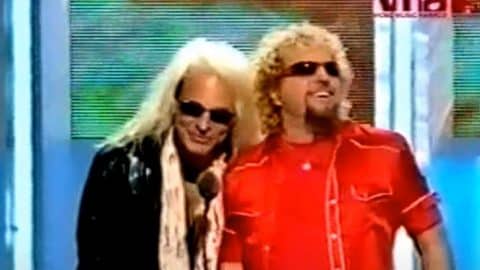What’s The Better Van Halen Era?

via couchtv english / Youtube
Van Halen, a band overflowing with musical talent, is often credited for bringing hard rock to the mainstream. However, controversy seems to follow them.
Recently, Wolfgang Van Halen declined to perform his late father Eddie’s iconic solo “Eruption” at the Grammys, and voiced disapproval over the brief tribute segment.
But this isn’t their first brush with drama. One of rock’s biggest feuds erupted when lead singer David Lee Roth left the band in the 1970s, replaced by Sammy Hagar.
Ever since, fans have passionately debated who the superior frontman is. Let’s delve into the arguments for each side.
https://twitter.com/HeavyMetal_999/status/1714281246648652241
David was the original voice
Roth’s legacy with Van Halen is undeniable. He was there from the very beginning, sharing the band’s genesis and understanding the musical direction envisioned by the Van Halen brothers.
Interestingly, their initial collaboration was purely economic, with the brothers renting Roth’s sound system. However, his impact went far beyond that initial deal.
Roth’s influence extended beyond the microphone. He even played a key role in shaping the band’s identity, famously suggesting the iconic name change from Mammoth to Van Halen. He envisioned the band following a similar marketing strategy to Santana, highlighting the frontman’s name.
This creative vision, combined with his powerful vocals and songwriting contributions, solidified Van Halen’s position as a musical powerhouse.
Sammy was the melodic mastermind
While David brought undeniable energy to Van Halen, some argue his on-stage theatrics overshadowed the band’s musicality. Sammy, however, brought a different perspective.
His focus shifted the band’s sound towards a more collaborative approach, where all members contributed significantly.
Hagar’s strength as a vocalist played a key role in this shift. His focus on rhythm and melody encouraged a tighter cohesion between him and his bandmates, fostering a true “band sound” instead of a frontman-centric one.
This shift, combined with his emphasis on melody over theatrics, resonated with many fans, who warmed up to his collaborative and musically-driven approach.
https://twitter.com/yusefmetal/status/1763130630613659887
David was the architect of the early sound
The self-titled Van Halen debut album, released in the late 70s, remains a cornerstone of the band’s legacy. This landmark release, fueled by the unique partnership between Eddie Van Halen and Diamond David Dave, established them as a force to be reckoned with.
Roth’s unconventional vocal style, praised by critics then and still relevant today, became a signature element of the band’s sound.
Many argue that Hagar, while immensely talented, wouldn’t have replicated the groundbreaking achievements of the debut album.
Roth’s daring approach to sound design, evident in iconic hits like “Running With the Devil” and “Eruption”, set the stage for Van Halen’s meteoric rise and cemented his place as a key architect of the band’s early sound.
Sammy was an improvisational powerhouse
While Roth’s stage presence was undeniable, Hagar brought a different kind of energy to Van Halen. He was known for being meticulously creative, spontaneous, and arguably even more versatile than Roth.
This multi-talented musician thrived in various settings, as evidenced by the story behind his audition.
During his tryout, Eddie Van Halen famously started playing a new song he’d been working on. Hagar, on the spot, improvised the lyrics that would become the foundation for “Summer Nights”, one of Van Halen’s most beloved songs – with 90% of the lyrics still stemming from that initial improvisation.
This anecdote perfectly captures Hagar’s ability to think on his feet and contribute creatively in the moment.
David was a visionary frontman
Beyond his undeniable stage presence, David is also recognized for his marketing savvy. He had a keen eye for the band’s strengths and, according to some, left the band due to fundamental artistic disagreements.
Roth envisioned Van Halen embracing a high-energy, hedonistic style akin to bands like AC/DC and KISS, prioritizing catchy anthems and celebratory vibes. In contrast, Eddie Van Halen aspired for a more introspective direction, with darker lyrics and lower musical keys.
While Eddie’s artistic vision held merit, many argue that Van Halen’s greatest successes lie in the high-octane power anthems that Roth championed.
These songs, fueled by his vision and Roth’s energetic performances, captured the hearts of millions and cemented Van Halen’s status as rock legends.
Sammy Hagar was a seamless harmonizer
Unlike many bands that undergo lead singer changes, Van Halen maintained their core identity with Sammy at the helm.
Hagar’s approach was meticulous and respectful of the band’s established sound. He brought creativity and precision to his vocals, ensuring they seamlessly blended with Van Halen’s signature style.
The Red Rocker was also a forward-thinking artist, introducing fresh elements that expanded the band’s sonic palette. Tracks like “Best of Both Worlds” and “Poundcake” showcased his ability to incorporate upbeat, unconventional, and even semi-acoustic elements, pushing the boundaries of American rock music.
These innovative contributions cemented his place as a valuable asset to the band’s evolution.
David was the king of stage presence
Roth’s electrifying stage presence became synonymous with Van Halen. His captivating energy and flamboyant showmanship quickly overshadowed Eddie for many fans.
Roth, not Eddie, became the face of the band, drawing attention with his theatrical antics and undeniable charisma.
While Sammy brought his own unique qualities as a performer, a direct comparison isn’t entirely fair. Hagar’s style leaned towards controlled originality, a stark contrast to Roth’s larger-than-life persona.
They thrived in different eras of the band, and each contributed significantly to Van Halen’s legacy.
https://twitter.com/historyrock_/status/1752621015610372252
Sammy was a genre-bending hustler
Hagar was a seasoned musician before joining Van Halen, having established himself as a force to be reckoned with in the rock world. He enjoyed success with the band Montrose and built a thriving solo career, exploring diverse styles within metal and hard rock.
This experience proved invaluable when he joined Van Halen, allowing him to seamlessly adapt and contribute to the band’s evolution.
Hagar’s diverse musical background played a crucial role in upgrading Van Halen’s sound for the 80s audience.
His versatility and knowledge of various sub-genres helped him inject fresh elements into the band’s music, keeping them relevant and appealing to new generations of fans.
David was a pioneering icon
David’s influence extends far beyond his time with Van Halen. His electrifying stage presence, dynamic vocals, and captivating looks, infused with punk-inspired energy, made him an instant rock icon in the 70s.
His success paved the way for a new generation of rock stars, including Vince Neil of Mötley Crüe and early Bon Jovi.
Roth’s impact was so profound that some argue his departure from the band left him with a bigger name than Van Halen itself.
His loyal fanbase, built during his years as frontman, solidified his status as a legendary and influential figure within the rock and roll landscape.
Sammy was the right man at the right time
For many Van Halen fans, Sammy’s arrival couldn’t have been better timed. The band was transitioning towards a more polished and mature sound, aiming for a “groovier” feel and a more diverse discography.
Hagar’s musical style perfectly complemented this evolution, delivering the smooth vocals and catchy melodies that resonated with the band’s maturing fanbase.
As Van Halen’s audience matured in the 1980s, their musical tastes evolved. Hagar’s addition allowed the band to maintain a strong connection with their established fans while also attracting new listeners.
His ability to seamlessly blend with Van Halen’s established sound while introducing fresh elements proved to be a key factor in the band’s continued success throughout the decade.











